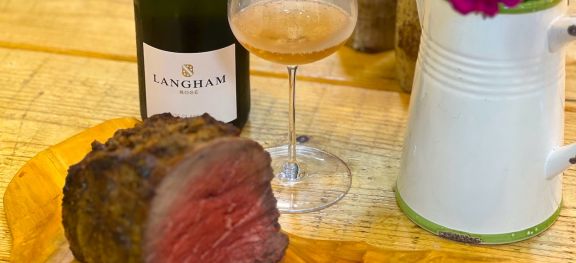Roast beef and pink fizz

6 February 2025 A surprising match made in heaven – republished, free for all, in our Throwback Thursday series.
8 February 2024 Whether you're looking for something special for Valentine's Day or to shake up Sunday lunch, here's a surprising and deliciously different pairing.
The last thing you’d pair with roast beef is pink fizz. I even checked with the experts. Fiona Beckett, The Guardian’s wine critic and founder of Matching food & wine calls for red bordeaux or bordeaux blends, but also includes Shiraz, Malbec and Rioja in her list of suggestions. Victoria Moore, in The Wine Dine Dictionary, lists a wide spectrum of red wines from Pinot Noir to Aussie Shiraz, bordeaux to Napa Cab, Tuscan reds to Argentine Malbec. François Chartier, in Taste Buds and Molecules, recommends ‘full-bodied, barrel-raised reds’ such as Sangiovese, Tempranillo, Nebbiolo and Malbec. Bert Blaize and Claire Strickett, in Which Wine When, are also adamant: full-bodied reds such as bordeaux, Malbec, Californian Zinfandel. I pulled out every book on my shelf with food and wine pairings and they all said the same, with some variations within the spectrum. Google it. Even Google knows that you pair red wines with roast beef.
The only contretemps I came across was Victoria Moore stating that rare roast beef should be paired with more tannic, older wines, and well-done roast beef should be paired with juicier, fruitier, younger reds. Beckett, on the other hand, claims the exact opposite, advising that, ‘rare beef suits young, full-bodied reds while older, more delicate reds are sometimes better with beef that’s cooked a little longer’. Moore’s reasoning is that juicy rare beef is complemented by drier, more tertiary wines, and that drier beef is complemented by juicier wines. Beckett thinks you should pair like for like: dry beef for dry reds, juicy beef for juicy reds. Moore is also more nuanced on the subject, suggesting Dolcetto or Garnacha with cold roast beef, and explaining that once you add in horseradish or mustard, you change the game entirely. Mustard can soften the harshest tannins, she says – so you can opt for Cahors. Horseradish, she advises, should push you in the direction of cooler-climate reds and green-herb Cabernets.
Not one single person suggested pink sparkling wine. But here I am, about to raise eyebrows in the bastions of tradition.
Put those reds to one side. Don’t even open them. Put a bottle of pink sparkling wine in the fridge. If it’s a romantic or special meal, make it a particularly special one. If it’s Sunday lunch, make it fun. If you’re curious, put three (or, heck, five) bottles of sparkling rosé in the fridge – each one a different style, price point, region. Do as we did (or rather, as I made my long-suffering fire chef do) and roast a chunk of grass-fed beef. Make sure you cook that beef rare, or at least medium rare. Season it with nothing but salt and pepper, perhaps a finger-tip smudge of unsalted butter. Slice thin while still hot (but rested) and serve with a glass (or all five glasses) of cold, crisp, pink sparkling wine. Just try it. No sides, no gravy, no sauces. Just warm, meltingly buttery, ruby-rare roast beef with umami-juices dripping down your chin, and the cold, electric zap of blood-orange, wild-strawberry and chalk-stones wine. It’s possibly one of the most shocking pairings I’ve ever tried. And then, after the shock, one of the most addictive.
The Maillard-rich, deep-timbred, uber-umami sweet savouriness and dense-velvet texture of the beef collides with the high-current, crystalline precision, fruit-saturated vibrating tension of the wine and the effect is like a tiny lightning bolt in the mouth. It’s a collision. It’s a physical reaction. You’ll try it, look up, and go: ‘oh wow’. (I rubbed my eyebrows, which is what I do when I can’t find words.) It’s as if the red fruit, the acidity, the bubbles and the leesiness of the pink fizz somehow step in as an understudy for red wine’s tannins, structure, fruit and power. But the understudy, naive and inexperienced, interprets the role differently. The understudy doesn’t imitate. The understudy takes things in a recklessly new direction. The wine seems to adore the beef (it sounds crazy, but you’ll see), making every tiny morsel of it taste even sweeter, more intense and (interestingly) silkier. The wine also cleanses the palate, so instead of feeling that slightly fatty-rich fatigue after eating roast beef, your palate finishes sharp and bright.
It’s also a pairing that is a contradiction. It tugs at something primeval but is also wickedly hedonistic. Rare roast beef is deeply carnivorous, and to eat it without the softening framework of vegetable sides makes it feel even more so. It comes with a weight of masculine associations. Pink fizz is, let’s be honest, intrinsically associated with celebration, ‘girlishness’ and frivolous fun, so much so that it’s often perceived as a giddy wine – most of us drink it at parties, with smoked-salmon canapés. Roast beef is serious and, instinctively, we reach for ‘serious’ red wines. To go for a rosé sparkling wine seems a little irreverent.
But it works. And it works on all levels (you don’t need £150 champagne – rosé crémant will do a great job). Best of all, it’s the gift that keeps on giving. It works the next day and the day after (and I’m not talking about the long-term impact of your Valentine’s date). Roast beef pretty much always yields leftovers and the best dinners (family or romantic) should always end in brunch. And the best wine for a cold, rare roast-beef sandwich, triple-loaded with mustard, horseradish and watercress, is pink sparkling wine.
For this sandwich, I’d go for English pink sparklings, because in my ‘trial’, the beef, watercress, horseradish, mustard, bread, onions and butter were all English. And pink English fizz has a particularly sharp accentuation of fruit and acidity that stands toe to toe with mustard and horseradish, and adds a particular brightness to the sweet-iron nuances of rare beef. Champagne feels more celebratory and reckless but I found it was perhaps less precise, although I was surprised by how good the slightly sweet Taittinger was with the combo. But you can make this yours. In our tasting notes database, we have notes on more than 1,600 rosé sparkling wines from 30 countries. There’s a rosé sparkling wine for every roast-beef dish.
Photos of beef dishes are the author's own; centre photo by Brett Stevens via Getty Images.
Become a member to view this article and thousands more!
- 15,436 featured articles
- 274,222 wine reviews
- Maps from The World Atlas of Wine, 8th edition (RRP £50)
- The Oxford Companion to Wine, 5th edition (RRP £50)
- Members’ forum
- 15,436 featured articles
- 274,222 wine reviews
- Maps from The World Atlas of Wine, 8th edition (RRP £50)
- The Oxford Companion to Wine, 5th edition (RRP £50)
- Members’ forum
- Commercial use of our Tasting Notes


